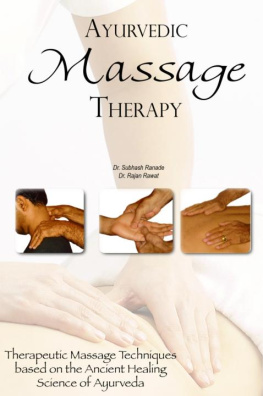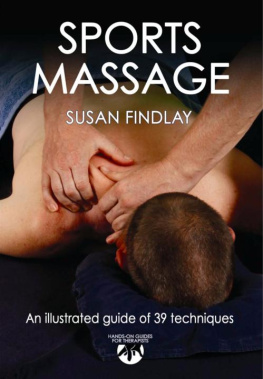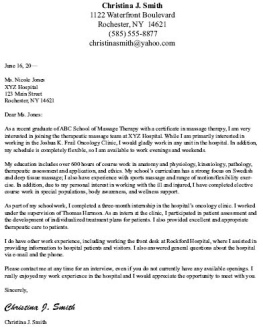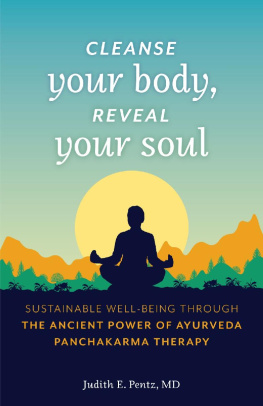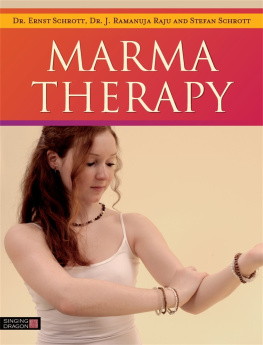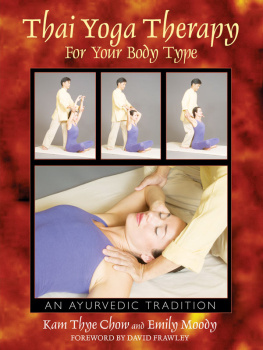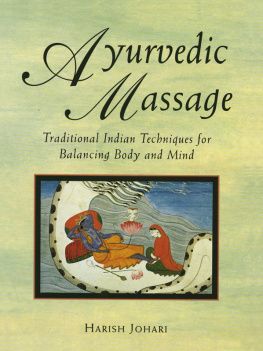Dr. Subhash Ranade
Dr. Ra ja n Rawat






ChapterPage
................................................................. 1
.............................................................. 31
.................................................... 33
.................................................................... 53
............................................... 122
Massage is an ancient Indian art used for healing and relaxation as well as for treating various diseases. The touch of massage can bring about dramatic changes in the body and mind. Ayurvedic massage has many unique features and advantages versus any other oriental or modern system of massage.
Ayurvedic massage is done according to body constitution, age, stage of the disease, aggravated doshas, status of agni and ama. With this understanding, the Ayurvedic masseur can choose the correct type of oil or other substances for massage, bringing about dramatic results for both healthy as well as diseased patients.
In spite of the development of sophisticated equipment for treating various physical injuries and a wide range of electrical apparatus, it is quite surprising that if one understands the fundamental principles of Ayurveda, and the correct oil or substance and methods are used, much better results can be found.
Many authors have written about Ayurvedic massage. However, very few have given proper consideration to the basic principles of Ayurveda. Therefore, while writing this book, we have explained the fundamental principles of Ayurveda in the first chapters. Later on we have explained various methods, as well as oils and other substances used for massage.
For the first time we have explained the very important concept of "Marma massage" which is becoming very popular not only in India, but also abroad. The chapter on "Massage for Specific Diseases" has highlighted some important diseases in which massage can be very useful.
The authors are thankful to Dr. Ajit Mandalecha for providing valuable material and helpful suggestions.
We wish to also mention the efforts taken by David Freedman who is one of my students from the AYU Ayurvedic Academy, directed by Dr. Vivek Shanbhag. David has taken a lot of effort in the editing of this book, including rewriting many concepts and rephrasing them so that the entire matter will be user friendly to Western readers. He has devoted many months of his valuable time and we have no words to thank him.
We hope that this book will receive a good response from the Ayurvedic as well as other scientific communities.

Ayurveda is the traditional medicine of India. It has a very long history, having been practiced continually for over 5,000 years. Having existed for such a long time, Ayurveda is notjusta medical system, it is an integral part of Indian culture. Massage is one of many techniques used in Ayurveda for both treatment and prevention of disease. In this book you will find specialized Ayurvedic massage techniques, lists of therapeutic oils and treatments for specific diseases using Ayurvedic massage. The section on self massage is important as daily self massage can prevent many health disorders.
We have explained some of the main concepts of Ayurvedic medical theory including a questionnaire to help determine your particular body type, which is a main focus of Ayurvedic practice. English translations are used whenever possible, with Ayurvedic terms following in parenthesis. Many quotations from classical textbooks have been included. These are followed by abbreviations such as Su (Sushruta), Ch (Charaka),AH (Ashtanga Hridaya), etc. A listing of these classical texts and the abbreviations used can be found near the end of the book.
For those with a background in Ayurveda, differences may be noted from other books or teaching in regard to explanation of certain concepts and techniques. This is common in Oriental medicine and is usually due to different interpretations and schools that have evolved over a long period of time.
As you read through the book you may find spellings that are slightly different than you have seen before. This is part of the rich culture of India where there are currently in use 29 different languages and 300 different dialects. An example is the common replacement of letters in words. This changes sattva to sattwa, basti to vasti, marma to varma or Prakruti to Prakriti. The spelling is different, but the meaning is still the same.
We hope that you find this book both interesting and useful and that it enriches both your life and the lives of others.


A word for massage exists in almost every culture. Massage is perhaps the most popular form of health activity today. It is effectively used for achieving relaxation and as a form of natural therapy for various diseases. The art of massage has been practiced since ancient times and in many countries. Early physicians used massage effectively in treating fatigue, illness and injury. Studies of classical texts indicate that the ancient Chinese, Greeks and Romans all practiced a form of massage. Roman and Greek philosophers and physicians prescribed massage not only for its restorative powers after battle, but for general health of the body and mind. The ancient Greeks established massage schools in their gymnasiums and used massage for maintaining health as well as for treating various diseases. The famous Greek poet Homer mentions beautiful girls giving massage to the fatigued soldiers who returned from war.
In the Far East, the Indian cultures and their epic texts like Ramayana and Mahabharata describe massage for health maintenance. The Bhavishya Purana, which is a very ancient text, mentions different techniques of massage. These techniques include how a wife should give massage to her husband, both for health benefits and for increasing sexual power and enjoyment. In India, performing musicians and actors learn massage practices to aid their artistic development. In the book Vatsyayana I
In some societies massage has been used socially as an act of hospitality, as in Hawaii, where passive movements called Lomi-Lomi are bestowed on honored guests. This is a traditional massage of Hawaii and gives relaxation to all the muscles in the body.

